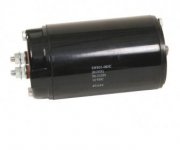This winch had sat unused for a few years...went to use it and it's seized up.
I took it apart, and find it'd drawn moisture, the rotor wouldn't turn because of rust between it and the magnets making up the poles.
It's a "Superwinch"....
Each pole is made up of 4 pieces making a whole half. You can't really make it out in the photo because of all the particles of rust and gunk.
The bolts holding the motor to the winch run between and separate the poles. They were swelled up with rust.
Anyhow, taking it apart, I find that there was some sort of adhesive holding the magnets in place in the housing. The adhesive had failed.
I cleaned out everything... got the magnets put back in place.. but have come to the conclusion that it won't work without the magnets being fastened in place. Without that glue, as soon as you put the rotor through, the magnets are attracted to it and pull away from the motor housing.
Not spending a $100 on a new motor.. I have another winch I can use. Upon further googling... they are a common DC motor..(short shaft, with a tang on the end)... and found one for $71.. still....
I just hate to let it go without a fight.
What adhesive would I use?
I took it apart, and find it'd drawn moisture, the rotor wouldn't turn because of rust between it and the magnets making up the poles.
It's a "Superwinch"....
Each pole is made up of 4 pieces making a whole half. You can't really make it out in the photo because of all the particles of rust and gunk.
The bolts holding the motor to the winch run between and separate the poles. They were swelled up with rust.
Anyhow, taking it apart, I find that there was some sort of adhesive holding the magnets in place in the housing. The adhesive had failed.
I cleaned out everything... got the magnets put back in place.. but have come to the conclusion that it won't work without the magnets being fastened in place. Without that glue, as soon as you put the rotor through, the magnets are attracted to it and pull away from the motor housing.
Not spending a $100 on a new motor.. I have another winch I can use. Upon further googling... they are a common DC motor..(short shaft, with a tang on the end)... and found one for $71.. still....
I just hate to let it go without a fight.
What adhesive would I use?




